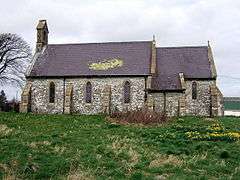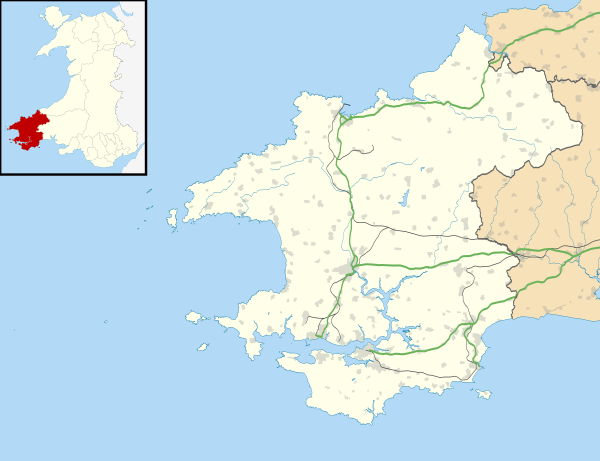Llantood
Llantood (formerly Llantyd, Llantwyd or Llan-Illtyd) is a hamlet and parish in Cilgerran community, north Pembrokeshire, Wales.
Llantood
| |
|---|---|
 Parish church of St Illtud | |
 Llantood Location within Pembrokeshire | |
| Community | |
| Principal area | |
| Country | Wales |
| Sovereign state | United Kingdom |
| Post town | Cardigan, Ceredigion |
| Postcode district | SA43 |
| Dialling code | 01239 |
| Police | Dyfed-Powys |
| Fire | Mid and West Wales |
| Ambulance | Welsh |
| UK Parliament | |
| Senedd Cymru – Welsh Parliament |
|
Location
Llantood is 3 miles (4.8 km) south-west of Cardigan on the A487 Cardigan to Newport road near the north Pembrokeshire coast. It consists of a few houses, farms and a parish church on an open hill agricultural area averaging 150 metres (490 ft) above sea level. Nearby settlements include Bridell, Glanrhyd, Monington, Pontgarreg and Tygwyn.[1]
History
Evidence of prehistoric occupation can be seen by the remains of fortifications at Penralltddu, a scheduled monument, and at Castell Felinganol (or Castellfelorganol).[2]
The name of the hamlet is assumed to derive from the 5th century saint, Illtyd, to whom the parish church is now dedicated. Church records date back to 1674, and the parish was in the Hundred of Kilgerran (formed in 1536)[3] even though it was in the Cemais administrative area.[4] The region was occupied by the Normans in the 12th century, who built castles at several strategic locations in the area; the clear remains of a motte and bailey exists at Castell Penyrallt (or Castell Pen-yr-allt).[2] A clergyman in 1864 remembered stonework on the latter, but this was no longer evident at the time of the 1925 Royal Commission.[5] The Norman structure may have reused a prehistoric fort.[6]
The name of the parish church was Langetot in the Taxatio of 1293, as Langettod in the St David's episcopal register of 1513, and appears on a 1578 parish map of Pembrokeshire as Llantwood.[7]. The attachment to St Illtyd may therefore be of later origin.[5]
In 1870, Llantwyd was listed in Wilson's Gazetteer as consisting of 1,792 acres (725 ha), 61 houses and a population of 264.[8]
Significant buildings
Parish church
The present parish church of St Illtud dates from 1884, replacing an earlier church of 1820. Stones in the porch suggest there was a church as far back as the 13th century.[2]
.jpg)
Tredefaid
A Grade II listed farmhouse, dating back to the 17th century or earlier. It was originally the home of the Lewes family, and later the Bowen family.[9][10]
Penralltddu
A Victorian farmhouse built for J. W. Bowen in 1861 on the site of an earlier house dating back at least to 1773.[2]
Pentre Solar
A development of six sustainable homes at Glanrhyd was approved by the Pembrokeshire Coast National Park's planning committee in June 2014, with conditions that the buildings would be manufactured locally and free solar powered electricity would be provided.[11] The development was completed in 2017.[12]
References
- "GENUKI: parish map 6: Llantood". Retrieved 28 July 2019.
- Thomas Lloyd, Julian Orbach, Robert Scourfield (2004). Pembrokeshire. Yale University Press. p. 258-9.CS1 maint: multiple names: authors list (link)
- "GENUKI: Llantood". Retrieved 9 June 2014.
- Charles, B. G. (1973). The Second Book of George Owen's "Description of Pembrokeshire". National Library of Wales Journal, V. p. 265-285.
- Royal Commission on the Ancient and Historical Monuments of Wales. H.M. Stationery Office. 1925. p. 180. Retrieved 9 June 2014.
- "Dyfed Archaeological Trust". Retrieved 9 June 2014.
- "Penbrok comitat". British Library.
- "A vision of Britain through time - Llantwyd". Retrieved 9 June 2014.
- "British Listed Buildings". Retrieved 9 June 2014.
- Cadw. "Tredefaid (Grade II) (11978)". National Historic Assets of Wales. Retrieved 29 July 2019.
- "Sustainable homes go-ahead". Tivyside advertiser. 19 June 2014. Retrieved 19 June 2014.
- Steven Morris (6 January 2017). "Inside Glanrhyd, the first solar 'eco hamlet' in Wales". The Guardian. Retrieved 29 April 2019.